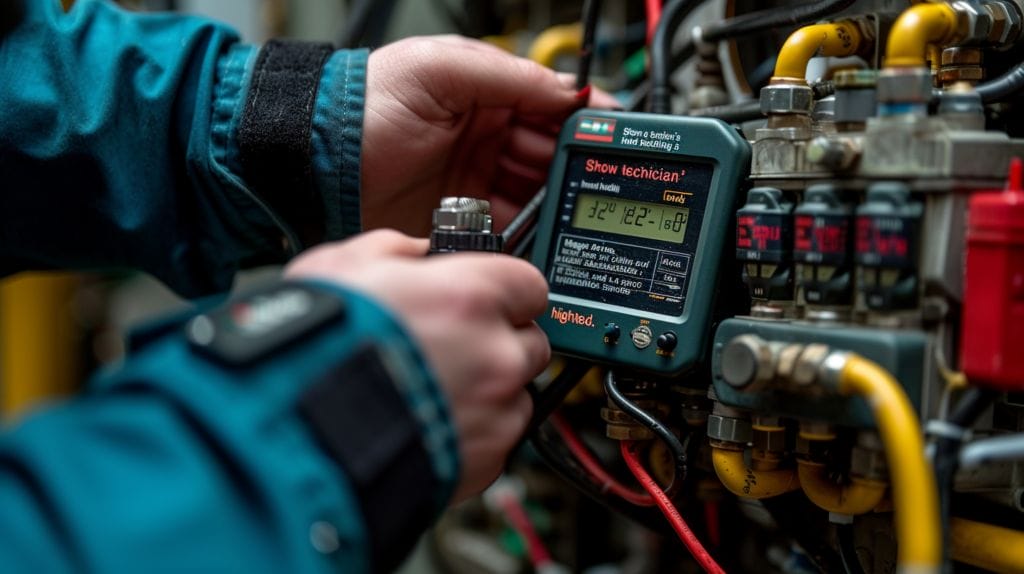Meg A Motor: The Complete Guide to Performing a Megger Test
Just as a doctor uses a stethoscope to check a patient’s health, we use a Megger test to gauge the health of a motor’s insulation. This crucial tool in our preventive maintenance arsenal helps identify potential issues before they evolve into serious, costly problems.
In our ‘Meg A Motor’ guide, we will walk you through the process of performing a Megger test – from initial preparation to interpreting the results. We aim to unravel the complexity of this invaluable procedure. By the end, you’ll wonder how you ever managed your motor maintenance without it.
Key Takeaways
- Megger testing is crucial for motor maintenance as it helps detect insulation degradation and prevents major failures.
- Regular Megger testing reduces downtime and integrates test results into maintenance records for a comprehensive approach.
- Megger testing enables effective preventive maintenance planning, increases the lifespan of motors, and saves costs associated with major repairs or replacements.
- While Megger testing has limitations, such as not detecting all insulation issues or providing information on the mechanical condition of the motor, it should be used in conjunction with other diagnostic methods for a comprehensive assessment.
Understanding the Megger Test and its Importance in Motor Maintenance

A Megger test is an insulation resistance test used to measure the insulation resistance of electric motors. This test is crucial as it provides insight into the motor’s health, helping to predict potential failures before they occur. By conducting a Megger test, we ensure the safe operation of our motors, thereby preventing expensive and dangerous equipment failures.
Why is the measurement of insulation resistance vital for motor maintenance? The insulation of a motor keeps the electricity where it should be. If it begins to fail, it could lead to short circuits, motor malfunctions, or even dangerous electrical fires. By performing a Megger test, we ensure the insulation is in good condition, thereby supporting the longevity and safe operation of our motors.
As technology advances, the need for preventative maintenance tools like the Megger test becomes even more significant. Regular testing not only helps us maintain our motors effectively but also allows us to embrace innovation by adopting a proactive approach to motor maintenance.
Preparation and Equipment for Conducting a Megger Test

For professionals seeking accurate electrical insulation measurements, our ‘Megger Test Guide’ is an invaluable resource.
- The guide starts with the essential steps of selecting the right megger instrument and ensuring all safety precautions are in place. It’s important to choose an instrument that suits your specific testing needs, and we’ve got plenty of innovative options to recommend.
- Once you’ve got your megger, you’ll need to connect it properly to the motor. This is a critical step in obtaining precise measurements.
- Safety can’t be overstressed either – we’re dealing with electricity after all. We’ll guide you through all the necessary precautions to protect both you and your equipment.
With our guide, you’ll be ready to conduct a Megger test with confidence and precision.
Step-by-Step Guide to Perform a Megger Test on Motor Insulation

After equipping you with the right tools and safety precautions, we’re now going to walk you through the process of performing a Megger test on motor insulation step by step. This process leverages a tool called a megohmmeter, a device designed to measure the insulation resistance of electric motors.
- Firstly, ensure the motor is powered off and disconnected from all power sources. Safety is paramount when we’re dealing with high voltages.
- Next, identify the motor’s phase wires or terminals. These will be your test points.
- Now, it’s time to bring out the megohmmeter. Connect its leads to the motor’s phase wires or terminals. Once connected, apply voltage as instructed by the megohmmeter’s user guide. Be cautious here as voltages can be high, reinforcing the need for proper safety gear.
- The megohmmeter will now do its job, sending a small DC voltage through the motor insulation. This is a non-destructive test meaning it won’t damage your motor insulation. It measures the insulation resistance using this applied voltage, providing you with a reading on the meter.
- The final step is interpreting these readings. Typically, a high resistance reading is a good sign. It indicates that the motor insulation is intact and functioning well. However, low readings can signify a problem. Common issues might include aging insulation, contamination, or physical damage.
That’s it! You’ve successfully conducted a Megger test on your motor insulation. Always remember, understanding and maintaining your motor’s insulation is a crucial part of ensuring long-lasting and efficient motor performance.
Interpreting Megger Test Results and Troubleshooting Insulation Issues

A Megger test offers us the ability to analyze the quality of electrical insulation. One of the primary ways we do this is through resistance tests. These tests measure the resistance of the insulation and helps us identify any potential weaknesses or failures. But what do the results really mean?
If the resistance measurements are high, it generally means that the insulation is in good condition. Lower resistance readings, on the other hand, often indicate potential issues with the insulation. It’s essential to keep these facts in mind when interpreting megger test results and troubleshooting insulation issues.
Now, if you’re dealing with low resistance measurements, you might be scratching your heads, wondering what could be causing these issues. Here are some common causes to consider:
- Moisture or dirt on the insulation
- Deterioration due to aging or excessive heat
- Poor quality of insulation materials
- Damage to the insulation
Once we’ve identified potential issues, we must employ creative and innovative strategies for troubleshooting and resolving these insulation problems. If we follow the steps laid out in ‘Meg A Motor: The Complete Guide to Performing a Megger Test’, we can ensure the longevity and efficiency of our motors.
Incorporating Megger Testing into Preventive Maintenance Programs

Implementing Megger testing into your preventive maintenance programs can significantly enhance the lifespan and performance of your motors, making our guide an invaluable resource for facility managers and maintenance technicians. We’re talking about a proactive approach here, one that’s designed to catch potential issues before they become major problems.
By scheduling regular Megger tests, we’ll be able to spot insulation degradation in your motors early on. This aids in planning preventive maintenance activities, thus reducing downtime. We also recommend integrating these test results into your maintenance records. In doing so, we’ll have a comprehensive and innovative approach to maintenance, one that leverages technology for pinpoint accuracy.
Trust us, it’s change worth making.
Conclusion
In wrapping up, we’ve shown you how crucial a Megger test is in maintaining your motor’s health. We’ve walked you through the steps, discussed the necessary equipment, and explained how to interpret results.
With this knowledge, you’re now ready to troubleshoot insulation problems and incorporate Megger testing into your preventive maintenance program.
Remember, regular testing won’t only extend your motor’s lifespan but also improve its efficiency.
Frequently Asked Questions
What is a Megger test and why is it used?
A Megger test, or insulation resistance test, is used to measure the insulation resistance of electrical equipment and cables to ensure the effectiveness of their insulation system. It helps in identifying any potential issues with the insulation, such as moisture, dirt, or aging, which could lead to electrical faults.
How is insulation resistance measured during a Megger test?
Insulation resistance is measured using a Megger instrument, which applies a high voltage to the insulation and measures the resistance. The resistance value is typically measured in megohms.
When should a Megger test be performed on a motor winding?
A Megger test should be performed on motor windings periodically, especially after any maintenance or repair work. It is also recommended to conduct such tests when there are suspicions of insulation degradation due to factors such as temperature variations, vibration, or humidity.
How is a Megger test performed on motor windings?
When performing a Megger test on motor windings, the Megger lead is placed on the ground terminal or wire, and then on one of the phase wires. The insulation resistance is measured using the Megger instrument to assess the insulation’s condition.
What factors can affect the results of a Megger test?
Factors such as temperature, humidity, operating voltage, vibration, and the size and type of machinery can significantly impact the results of a Megger test. It’s important to consider these variables when interpreting the test results.







